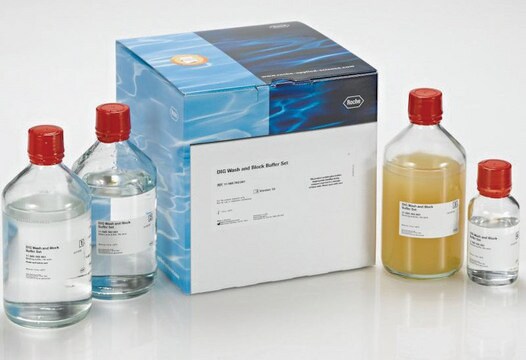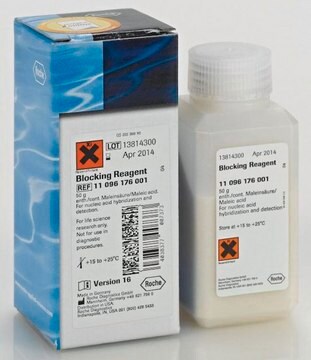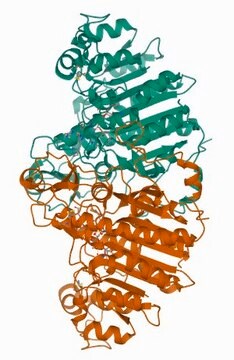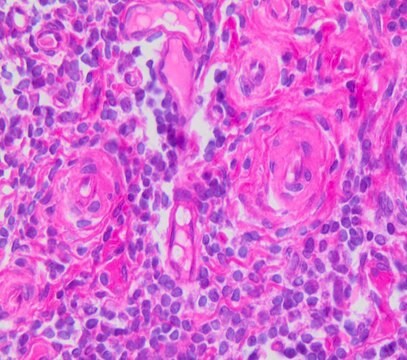PF092
Fas Ligand Plus, Human, Recombinant
Fas Ligand Plus, Human, Recombinant, consists of amino acids 103-281 fused to a 26-amino acid linker and FLAG®-tag at the N-terminus and expressed in HEK293 cells.
Iniciar sesiónpara Ver la Fijación de precios por contrato y de la organización
About This Item
Código UNSPSC:
12352202
NACRES:
NA.77
Productos recomendados
recombinante
expressed in HEK 293 cells
Nivel de calidad
Análisis
≥95% (SDS-PAGE)
formulario
lyophilized
fabricante / nombre comercial
Calbiochem®
condiciones de almacenamiento
OK to freeze
avoid repeated freeze/thaw cycles
Condiciones de envío
wet ice
temp. de almacenamiento
−20°C
Descripción general
Recombinant, human Fas ligand (amino acids 103-281) fused to a 26-amino acid linker and FLAG®-tag at the N-terminus and expressed in HEK293 cells. Does not require enhancer for activity. Suitable for cytotoxicity assays. M.W. 32,000 - 35,000.
Recombinant, human Fas ligand (amino acids 103-281) fused to a 26-amino acid linker and FLAG®-tag at the N-terminus and expressed in HEK293 cells. Glycosylation of recombinant human sFasL is similar or identical to natural human FasL. The molecular weight is ~32 kDa (nonglycosylated) and ~37-42 kDa (glycosylated) by SDS-PAGE under reducing conditions. The recombinant protein is produced in HEK293 cells. It does not require enhancer for activity. Useful for cytotoxicity assays.
Fas Ligand (FasL/APO-1L/CD95L) is a ~37-42 kDa type II transmembrane protein belonging to the TNF family. Interaction between FasL and Fas induces apoptosis of Fas-sensitive cells. FasL is implicated in CTL-mediated-killing, activation-induced cell death, creation of immune-privileged sites and tissue homeostasis. The extracellular domain of human FasL can be cleaved off by a metalloprotease, generating soluble FasL (sFasL). Circulating sFasL can be detected in serum of patients with melanoma and certain types of lymphoma.
Fas Ligand (FasL/APO-1L/CD95L) is a ~37-42 kDa type II transmembrane protein belonging to the TNF family. Interaction between FasL and Fas induces apoptosis of Fas-sensitive cells. FasL is implicated in CTL-mediated-killing, activation-induced cell death, creation of immune-privileged sites and tissue homeostasis. The extracellular domain of human FasL can be cleaved off by a metalloprotease, generating soluble FasL (sFasL). Circulating sFasL can be detected in serum of patients with melanoma and certain types of lymphoma.
Acciones bioquímicas o fisiológicas
≥1 ng/ml kills Fas-sensitive cells
Advertencia
Toxicity: Standard Handling (A)
Forma física
Lyophilized from PBS.
Reconstitución
Following reconstitution, aliquot and freeze (-20°C). Stock solutions are stable for up to 3 months at -20°C.
Reconstitute in 50 µl PBS to yield a final stock concentration of 100 µg/ml. Further dilute in culture medium with 5% FCS immediately prior to use.
Otras notas
Ashkenazi, A., and Dixit, V.M. 1998. Science281, 1305.
Nagata, S., 1997 Cell88, 355.
Hahne, M., et al. 1996. Science274, 1363.
Bellgrau, D., et al. 1995. Nature377, 630.
Lowin, B., et al. 1994. Nature370, 650.
Russell, J.H., et al. 1993. Proc. Natl. Acad. Sci. USA90, 4409.
Nagata, S., 1997 Cell88, 355.
Hahne, M., et al. 1996. Science274, 1363.
Bellgrau, D., et al. 1995. Nature377, 630.
Lowin, B., et al. 1994. Nature370, 650.
Russell, J.H., et al. 1993. Proc. Natl. Acad. Sci. USA90, 4409.
Glycosylation of recombinant human sFasL is similar or identical to natural human FasL. The molecular weight is ~32 kDa (nonglycosylated) and ~35 kDa (glycosylated) by SDS-PAGE under reducing conditions. The recombinant protein is produced in HEK293 cells. It does not require enhancer for activity.
Información legal
CALBIOCHEM is a registered trademark of Merck KGaA, Darmstadt, Germany
FLAG is a registered trademark of Merck KGaA, Darmstadt, Germany
Código de clase de almacenamiento
11 - Combustible Solids
Clase de riesgo para el agua (WGK)
WGK 1
Punto de inflamabilidad (°F)
Not applicable
Punto de inflamabilidad (°C)
Not applicable
Certificados de análisis (COA)
Busque Certificados de análisis (COA) introduciendo el número de lote del producto. Los números de lote se encuentran en la etiqueta del producto después de las palabras «Lot» o «Batch»
¿Ya tiene este producto?
Encuentre la documentación para los productos que ha comprado recientemente en la Biblioteca de documentos.
Nuestro equipo de científicos tiene experiencia en todas las áreas de investigación: Ciencias de la vida, Ciencia de los materiales, Síntesis química, Cromatografía, Analítica y muchas otras.
Póngase en contacto con el Servicio técnico








